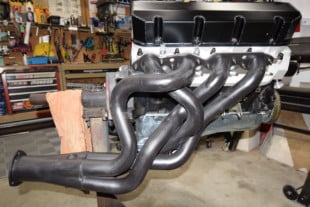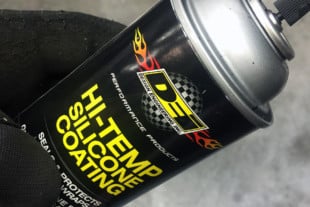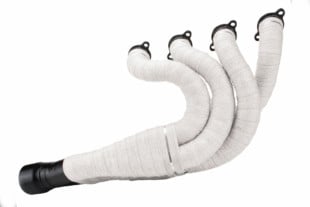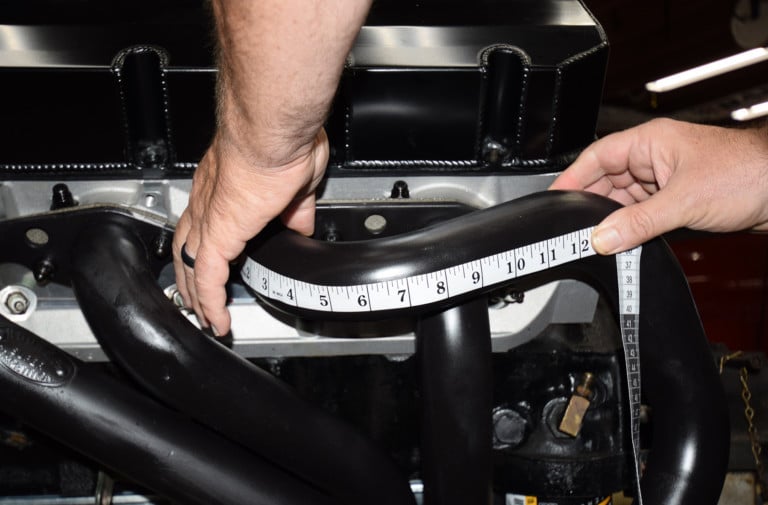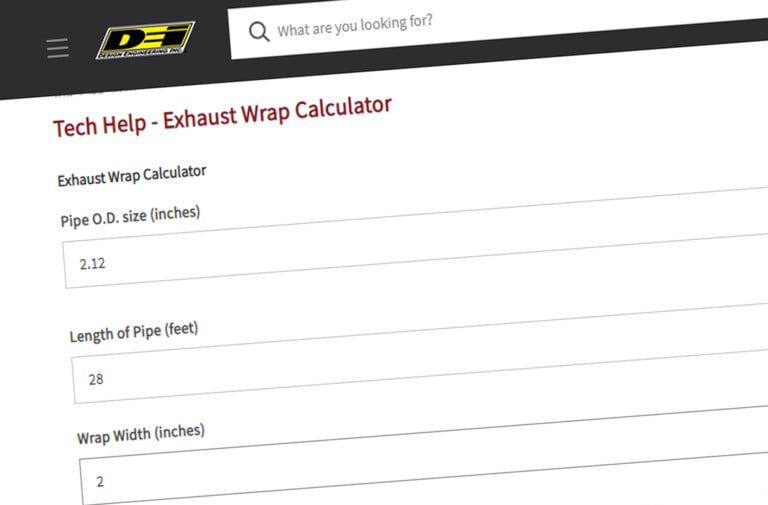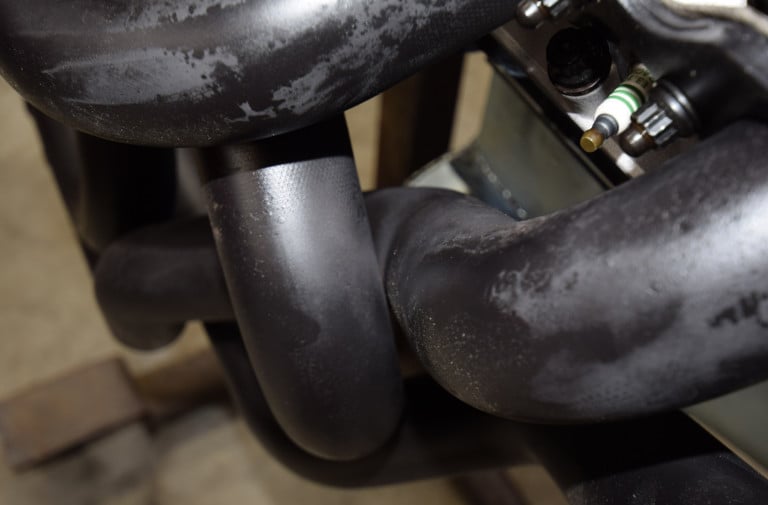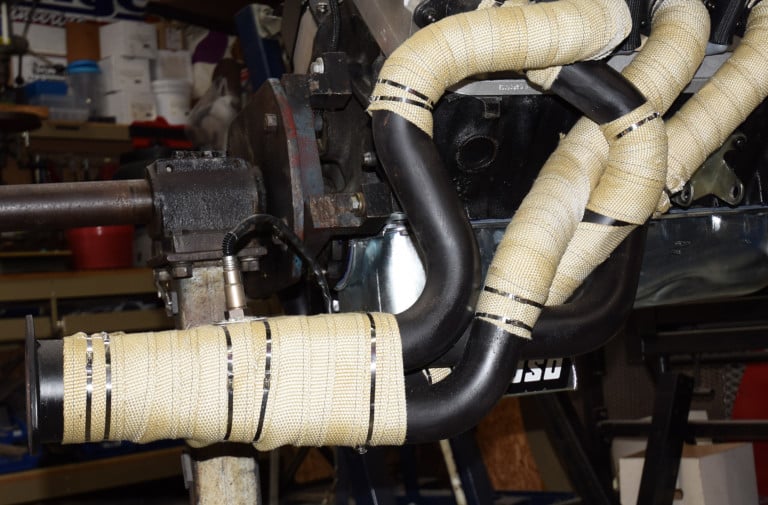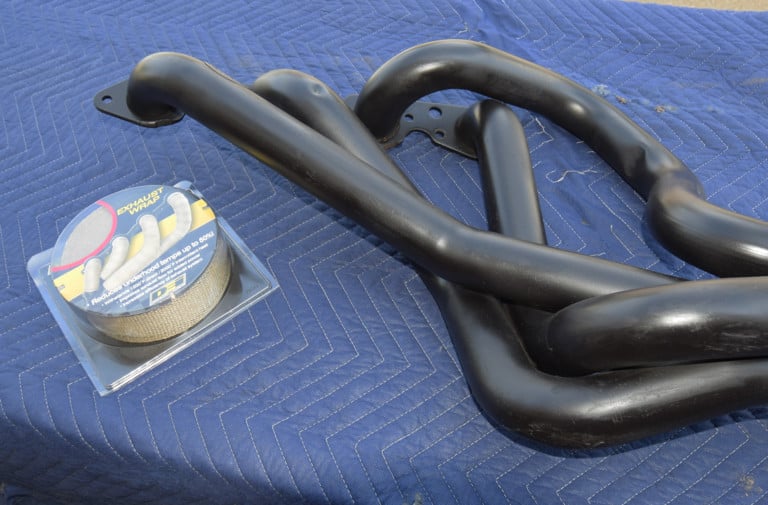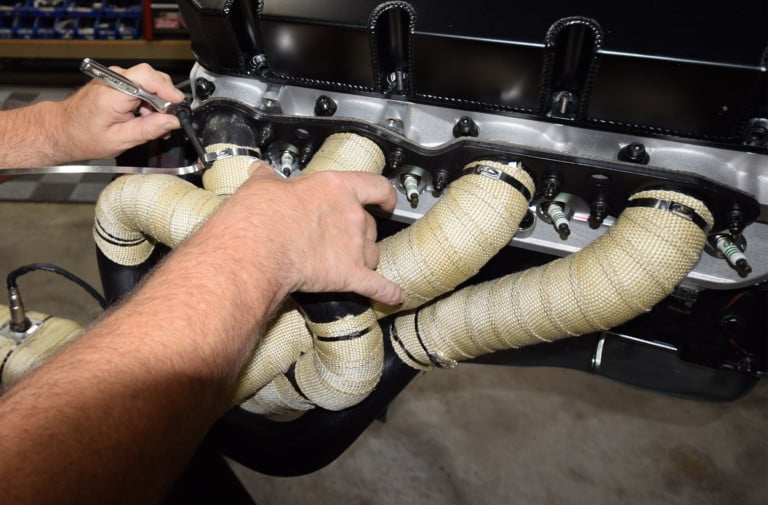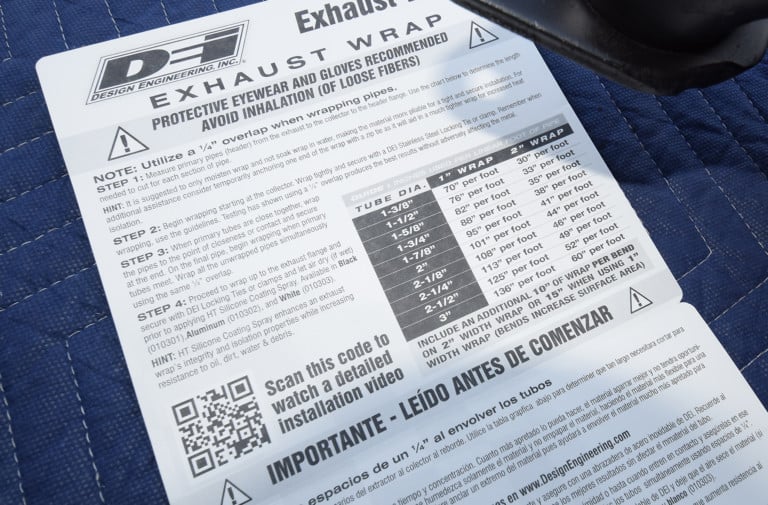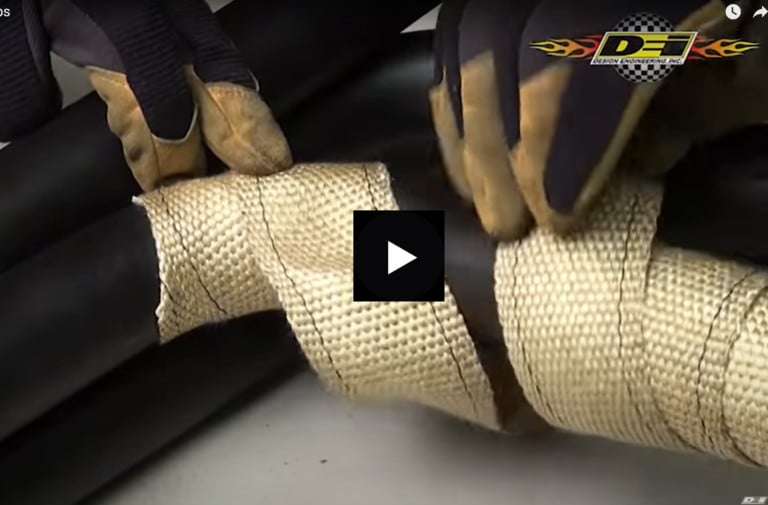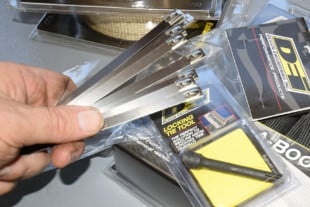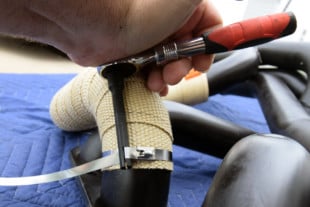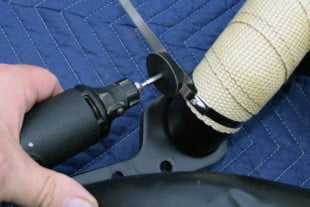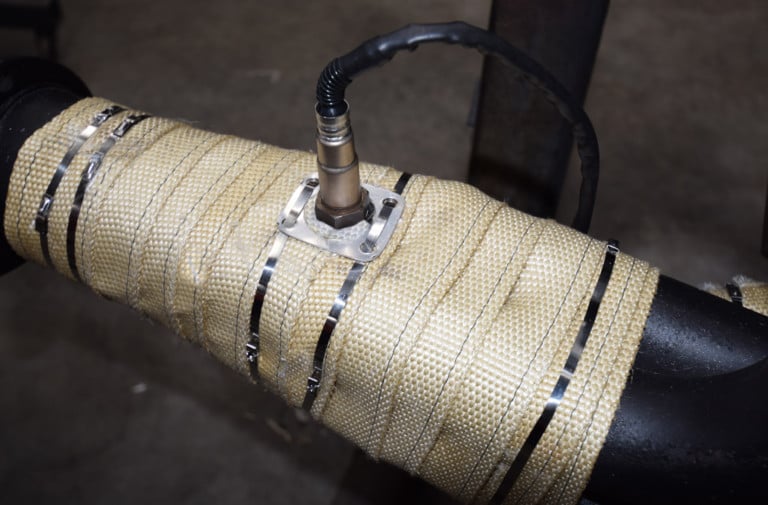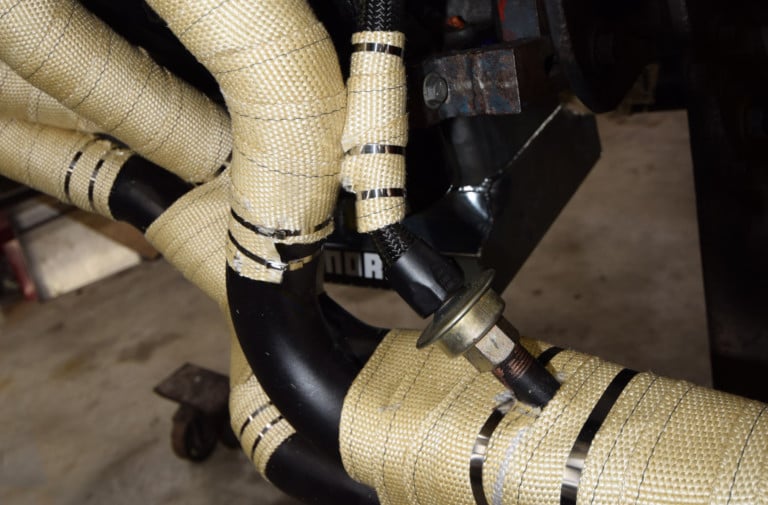When it comes to any internal combustion engine, increased horsepower applies the science of British Thermal Units per hour (BTUs.) That simplistic formula of heat versus temperature, BTU/hr = Horsepower x 2,545, spells out the fact that more horses mean more related heat.
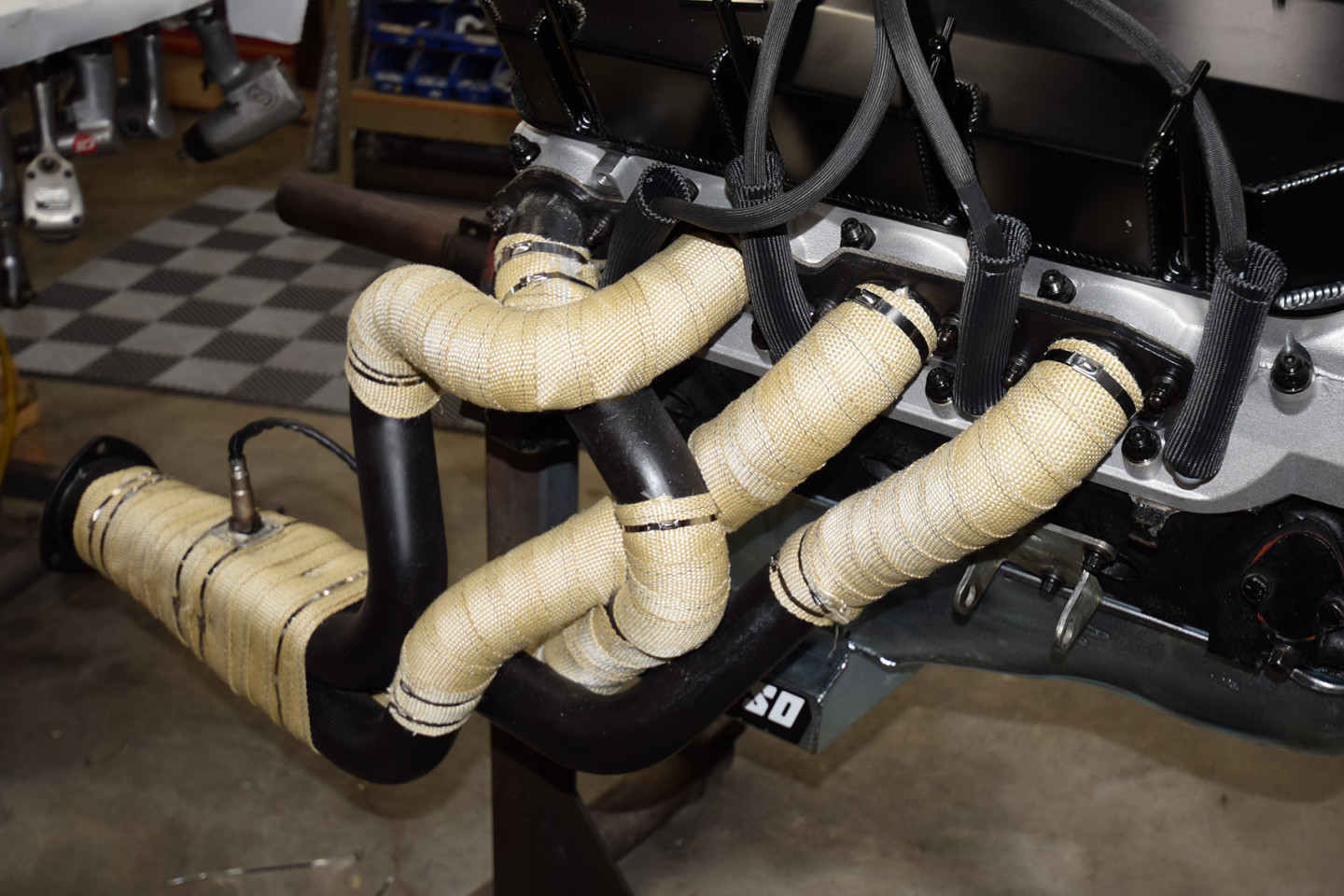
The products developed by Design Engineering Inc. (DEI) have declared war against the heat produced with the typical high-temp exhaust from performance and racing engines.
Project Rover (names as such because we’re teaching an old dog new tricks), our bracket-race 1968 Camaro, has been introduced to a new higher horsepower 489 cubic-inch big-block. With that horsepower comes heat, so we are taking advantage of Design Engineering‘s header wrap to make the hot rod more “hands-on” between rounds during raceday.
Our headers are a prime example of a header with extreme complexity. These Holley Performance/Hooker Super Competition headers route from the big-block heads between the Camaro’s tight inner frame rails. Wrapping those large 2.125-inch diameter tubes will illustrate a worst-case scenario of how to get the job completed for nearly any simpler header design.
We prepped and coated our headers with DEI Hi-Temp Silicone Coating. Available in white, aluminum, and black, this coating penetrates, seals, and protects. The spray is also recommended for coating the wrap's outer surface following installation. This can protect the wrap material from abrasion, rocks, and dirt when used on a street application.
To calculate the wrap length necessary for our order, DEI offers a handy header wrap calculator on its website. This online form allows you to punch in your accumulation of tube lengths, header tube diameter, the width of wrap used, and the amount of overlap you will execute. We know sections of the header pass very close to our chassis, and many of the individual header tubes are against each other in their routing. We slightly rounded down that calculation because there were areas that could not be wrapped.
When we ordered our wrap material, we used a cloth-tailor measuring tape to accurately calculate our individual tube lengths. We then used the wrap calculator at the DEI website to get our needed order in place.
We began our wrap effort by directly preparing and coating the headers with DEI’s Hi-Temp Silicone Coating Spray. Not only is this spray coating designed for painting your headers before wrapping, but it is also recommended as a coating once the headers are wrapped. DEI recommends using this coating with their finished wraps because it seals the material and provides lasting protection from road grime, dirt, etc.
The DEI silicone coating spray is also suggested to extend the wrap’s lifespan by directly applying it to the completed wrap surface. Since our car will never see actual highway use, we chose to leave that wrap uncoated and concentrate on properly prepping our header.
We decided to use DEI’s glass fiber exhaust wrap material. One of the advantages spelled out on the product literature include decreased exhaust density which increases horsepower, and at reduced underhood temperatures, a realistic 50-percent. This specific DEI wrap material offers direct heat resistance of 1200-degrees (Fahrenheit) and a radiant resistance of 2,000-degrees.
The tight header tubes come in contact with the chassis and each other at many points; this requires stopping and restarting the wrap multiple times. We prioritized wrapping a header tube closest to heat-sensitive components such as the oil filter, starter, and oil pan.
There are multiple options for header wrap material available from DEI. Its Titanium and EXO wraps each deliver outstanding heat reduction but with varying features. The black- or tan-colored EXO-Series exhaust wrap can withstand the extreme use that off-road, dirt track, desert, and other forms of driving have with exposure to water and dirt. The EXO Series is a dual-layer design, using a combination of hi-temp glass fiber, covered with a 304-grade stainless steel exoskeleton.
The other wrap material option is the DEI Titanium exhaust wrap. This wrap consists of material made from pulverized lava rock, stranded into a fiber material. This wrap is engineered to be stronger and offers improved thermal performance and reliability. The titanium exhaust withstands 1,800-degrees direct and 2,500-degrees of intermittent heat.
We wrapped our headers, rotating between the engine stand and a padded table. We bounced back and forth a few times to get the wrap as tight and concise as possible. The DEI stainless steel locking ties are the ticket for securing each end of your wrap and a few tight points between.
If you have ever burned your hands or arms working on an engine, then you know that both direct and radiant heat resistance is beneficial on the ‘outside” of a header, as well. I quickly learned one of the positive points when helping change spark plugs on a friend’s race car. Following a very short cool-down period, he pointed out I wouldn’t need to worry about header heat, as he grabbed a header tube with his bare hands with no problem.
Not only does wrapping cool your engine compartment, but from a technical standpoint, it can also produce horsepower. The theory of exhaust-cycle efficiency refers to the heat contained within the header exhaust gas. The scavenging effect is improved by controlling the heated gas in the header, promoting higher exhaust speed.
The instructions from DEI offer a wealth of info, including length calculators to cut your individual wrap sections, plus a QR code that allows you to watch an instructional video.
Offering an additional note of caution, you should know that the wrap material is not designed to be moved or removed after it has been through heat cycles. After the fibers have been heated, they lose their initial flexibility. The thermal properties of the exhaust wrap are not reduced, but it spells out that there are no “take-backs” once you run your engine.
When measuring to cut each length of wrap from the roll, make sure to move your measurements to the outside radius of each header bend. We learned to add approximately 7- to 10-inches to the measured length for each bend where the wrap consumes more material.
The DEI stainless locking ties are the header wrap ticket. Drawing the wrap securely with their dedicated tie tool, a ½-inch of the strap is left to fold under to eliminate any barbs. You can use a good pair of sidecuts, or we found that a small cutoff wheel makes a clean cut.
After the first couple of tubes were wrapped, we were beginning to get the hang of it. Our priority was to cover each tube to protect such adjacent hardware as our starter, ignition wires, oil filter, and fuel system as much as possible. This will also allow us to work around the engine during the battles of race day while minimizing “hot headers” for the crew.
As we progressed, we learned you could not have too many stainless-steel locking ties offered by DEI. The ties act similarly to a standard “zip tie,” locking as you tighten. Once we had each wrap completed and were happy with the result, we used a handy locking tie tool from DEI that pulled the tie tight.
With an evacuation tube and EGT sensor located at the collectors, we fabricated up some small sections of aluminum plate. We combined them with more stainless tie straps to capture the wrap and stop fraying in each area. We also used our last small bit of DEI wrap to protect the crankcase vent tube at the headers as well.
The tie tool twists and tightens to lift the tie away from the clasp. Be cautious not to over-tighten the tie as that could damage the clasp. We used a screwdriver-type attachment on our tool. In tight places, we used a small ratchet but were cautious about over-tightening. The literature instructs you to cut the excess tie with heavy-duty side cutters; we figured out that using a small rotary tool with a cutoff wheel works well in tight places.
The stainless ties can be used to prevent any buckling throughout the wrapping process. Extremely tight bend points can result in a looser wrap; we used these ties liberally to keep our tubes tightly wrapped overall. Another precaution we learned is to avoid any engine fluids or cleaners from getting into the wrap material. Though the various wrap materials offered by DEI are resilient, safeguarding against sloppiness of carb and brake cleaner or spilled oils is recommended.
If header wraps cool the engine compartment, there is a big plus. If it cools critical surfaces such as your oil pan and filter while offering more horsepower through dyno-proven exhaust-cycle efficiency, then plus-plus. No matter how many plus marks you add to the long list of DEI header wrap benefits, including not burning plug wires and even your hands, the win list of benefits is a sound investment.

